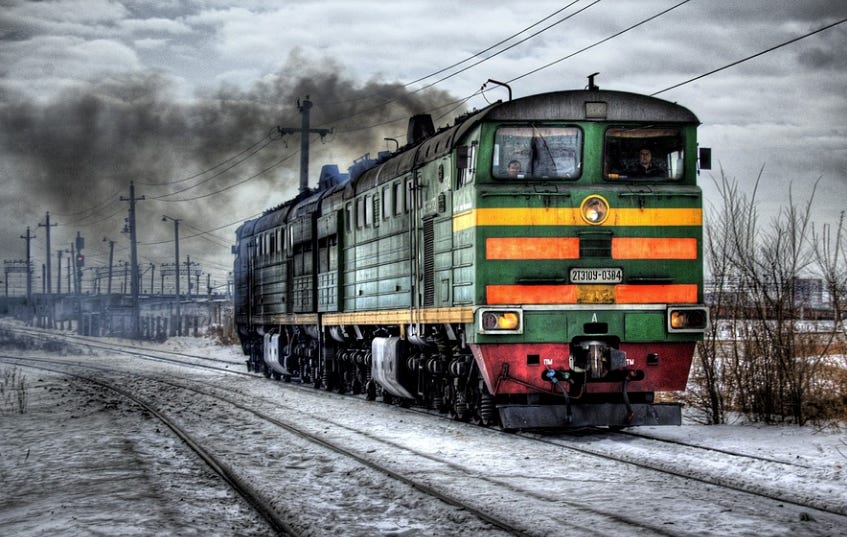Addressing the Railroad Crisis with a Sliding Scale Plan
There's a crisis with railroads. It's time to fix the industry's root flaw, which is the incentives that investors have to loot their companies instead of run the trains on time.
Welcome to BIG, a newsletter on the politics of monopoly power. If you’d like to sign up to receive issues over email, you can do so here
Most American freight travels over the rails, and railroads are essential to everything from package deliveries to the agricultural industry. It’s hard to convey the importance of the rail network because it’s invisible, but if rail shuts down, America shuts down.




For a long time we’ve known that the rail lines, which have consolidated dramatically since deregulation in the 1970s, do not service their customers particularly well. There are six class I railroads in the U.S., and most of them have moved to something called Precision Scheduled Railroading, which basically just means having fewer staff, less reliable scheduling and much longer trains. It’s a lot like the shipping industry, which now has much bigger boats, which ostensibly fosters more efficiency, but in reality fosters delays and supply chain crises.
Despite rail’s importance, most of the dominant firms in the industry continue to lay off workers and degrade service. For instance, in the five years prior to the pandemic BNSF cut its Train and Engine (T&E) workforce by 27%. NS has cut 24% of such employees, and UP has cut 32%. It’s not a surprise that the railroads are now having crew shortages.
And this observation isn’t some lefty crazy view. The high-powered lobbyists at the American Chemistry Council are frustrated as well, and they represent giant chemical companies that are not known to look kindly upon the demands of workers. The ACC”s President and CEO Chris Jahn complained earlier this year about the crisis.
“The problems we are experiencing today are not solely the result of the COVID-19 pandemic,” he continued. “Years of railroad decisions to cut staff, eliminate switch yards, and slash customer service resources have gutted network resilience, making service crises like this one entirely predictable, if not inevitable.”
What makes the current labor negotiations so ridiculous is that all the unions wanted were to be allowed to take days off for medical care without being subject to discipline. The railroads almost shut down the economy to stop that. It’s obvious that this is an industry that needs radical reform.
One key problem is that the railroads are run by financiers who seek to extract whatever they can from their capital heavy industry, regardless of the cost. They understaff their trains, they run unreliable service, they underinvest in capacity, and they let their capital stock degrade, all so they can pay out the $190B in buybacks and dividends they have done since the early 2010s.
So what’s the right reform? There are complex regulatory schemes we probably need to re-implement, but the reality is that no one actually knows how to regulate the railroads, and just figuring that out is going to take years. But there is a simple temporary solution. Let’s just make the ability of the owners of railroads to pay themselves dividends or engage in stock buybacks contingent upon them delivering good service to customers. To do that, they will need to hire enough workers and run the rail lines operationally well. And if they don’t, and increase profits by suppressing workers and service, they still won’t be able to pay themselves out via dividends and buybacks.
The Surface Transportation Board can start implementing this proposal by actually measuring rail service more accurately. And then, using either regulatory authority or seeking statutory grants from Congress, the STB can implement a sliding scale to require railroads to make their payouts to investors contingent upon reliable service.
Such a regulatory model has been tried, and worked, by none other than Louis Brandeis and the Public Franchise League over a hundred years ago. Boston had trouble with its gas utility, until it implemented such a scheme with the Sliding Scale Act of 1906, which drew from the British system and implemented "the automatic and interdependent adjustment of the price of gas to consumers and the rate of dividends to stockholders of gas companies."
The gas company management, after fighting the law, came to focus on operational efficiencies. The new regulatory scheme worked fantastically well, with the price of gas declining, profits for the utility increasing, and payouts to shareholders and the share price in turn going up. Eventually, the gas company management began rewarding employees for ideas and schemes to increase operational efficiency.
It was a big happy family, if you leave out the brutal fifteen years of political fighting during which the utility resisted such public utility rules. We don’t have that much time to fix this, so let’s hope the Biden Administration gets rolling in the right direction on the issue soon.



Interesting history re the sliding scale approach!